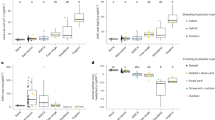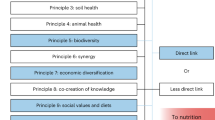Abstract
Co-culture systems can address food security issues by sustainably intensifying production of crops and animal protein without requiring additional land area. We show how a graph-theoretic optimization model based on ecological network analysis can determine robust co-culture strategies by controlling the presence of key species. Results of simulations on a hybrid rice and crayfish production system indicate that comparable levels of productivity can be achieved with different ecological network structures.
This is a preview of subscription content, access via your institution
Access options
Access Nature and 54 other Nature Portfolio journals
Get Nature+, our best-value online-access subscription
$29.99 / 30 days
cancel any time
Subscribe to this journal
Receive 12 digital issues and online access to articles
$119.00 per year
only $9.92 per issue
Buy this article
- Purchase on Springer Link
- Instant access to full article PDF
Prices may be subject to local taxes which are calculated during checkout


Similar content being viewed by others
Data availability
Data used in the analysis can be obtained via https://github.com/EcologicalP-Graph/Optimal-rice-crayfish-co-culture-system-/find/main.
Code availability
The software P-graph Studio (v.5.2.2.2) is hosted by the Department of Computer Science and Systems Technology at the University of Pannonia in Hungary21. It is available free of charge for research purposes via www.p-graph.org. The current v.5.2.2.2 runs in Microsoft Windows. The following specifications are required: Microsoft.NET Framework 4.5.1 (x86 and x64) and Windows Installer 4.5. Interested readers can replicate or modify our results using the P-graph Studio model file accessible via https://github.com/EcologicalP-Graph/Optimal-rice-crayfish-co-culture-system-/find/main.
References
Lee, K., Khanal, S. & Bakshi, B. R. Techno-ecologically synergistic food–energy–water systems can meet human and ecosystem needs. Energy Environ. Sci. 14, 3700–3716 (2021).
Ray, D. K. et al. Climate change has likely already affected global food production. PLoS ONE 14, e0217148 (2019).
IPCC Climate Change 2022: Impacts, Adaptation, and Vulnerability (eds Pörtner, H.-O. et al.) 1–35 (Cambridge Univ. Press, 2022).
Godfray, H. C. J. et al. Food security: the challenge of feeding 9 billion people. Science 327, 812–818 (2010).
Bashir, M. A. et al. Co-culture of rice and aquatic animals: an integrated system to achieve production and environmental sustainability. J. Clean. Prod. 249, 119310 (2020).
Dong, S. et al. Evaluation of the trophic structure and energy flow of a rice–crayfish integrated farming ecosystem based on the Ecopath model. Aquaculture 539, 736626 (2021).
Polovina, J. J. Model of a coral reef ecosystem—I. The ECOPATH model and its application to French Frigate Shoals. Coral Reefs 3, 1–11 (1984).
Geary, W. L. et al. A guide to ecosystem models and their environmental applications. Nat. Ecol. Evol. 4, 1459–1471 (2020).
Fath, B. D. et al. Ecological network analysis metrics: the need for an entire ecosystem approach in management and policy. Ocean Coast. Manag. 174, 1–14 (2019).
Diffendorfer, J. E., Richards, P. M., Dalrymple, G. H. & DeAngelis, D. L. Applying linear programming to estimate fluxes in ecosystems or food webs: an example from the herpetological assemblage of the freshwater Everglades. Ecol. Model. 144, 99–120 (2001).
Bolton, S. in Encyclopedia of Ecology 2nd edn, Vol. 4 (ed. Fath, B. D.) 493–497 (Elsevier, 2019).
Galaitsi, S. E., Keisler, J. M., Trump, B. D. & Linkov, I. The need to reconcile concepts that characterize systems facing threats. Risk Anal. 41, 3–15 (2021).
Lao, A., Cabezas, H., Orosz, A., Friedler, F. & Tan, R. Socio-ecological network structures from process graphs. PLoS ONE 15, e0232384 (2020).
Friedler, F., Aviso, K. B., Bertok, B., Foo, D. C. Y. & Tan, R. R. Prospects and challenges for chemical process synthesis with P-graph. Curr. Opin. Chem. Eng. 26, 58–64 (2019).
Heymans, J. J. et al. Best practice in Ecopath with Ecosim food-web models for ecosystem-based management. Ecol. Model. 331, 173–184 (2016).
Hu, L. et al. Can the co-cultivation of rice and fish help sustain rice production? Sci. Rep. 6, 28728 (2016).
He, M., Liu, F. & Wang, F. Resource utilization, competition and cannibalism of the red swamp crayfish Procambarus clarkii in integrated rice-crayfish culture without artificial diets. Aquac. Rep. 20, 100644 (2021).
Xu, Q. et al. Conversion from rice–wheat rotation to rice–crayfish coculture increases net ecosystem service values in Hung-tse Lake area, east China. J. Clean. Prod. 319, 128883 (2021).
Kurth, M. et al. A portfolio decision analysis approach to support energy research and development resource allocation. Energy Policy 105, 128–135 (2017).
Friedler, F., Pimentel Lozada, J. & Orosz, Á. P-Graphs for Process Systems Engineering: Mathematical Models and Algorithms (Springer Nature, 2022).
P-Graph (accessed 10 August 2021); www.p-graph.org
Acknowledgements
The research contributions from H.C. were done under the National Research, Development and Innovation Office (NKFIH), NKFIH Identifier: 135854.
Author information
Authors and Affiliations
Contributions
H. C. and R.R.T. conceived the study. K.B.A. developed the model. A.R.L. created the graphics. All authors analysed the data, wrote the article and did the revisions.
Corresponding author
Ethics declarations
Competing interests
The authors declare no competing interests.
Peer review
Peer review information
Nature Sustainability thanks Igor Linkov, Shweta Singh and David Styles for their contribution to the peer review of this work.
Additional information
Publisher’s note Springer Nature remains neutral with regard to jurisdictional claims in published maps and institutional affiliations.
Supplementary information
Supplementary Information
The Supplementary Information contains complete information on the 60 different ecosystem structures that were studied in this work, including Tables 1–15 and Figs. 1–12.
Rights and permissions
About this article
Cite this article
Lao, A.R., Aviso, K.B., Cabezas, H. et al. Maintaining the productivity of co-culture systems in the face of environmental change. Nat Sustain 5, 749–752 (2022). https://doi.org/10.1038/s41893-022-00912-w
Received:
Accepted:
Published:
Issue Date:
DOI: https://doi.org/10.1038/s41893-022-00912-w
This article is cited by
-
Networking for food production
Nature Sustainability (2022)



